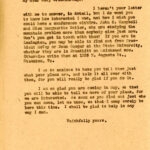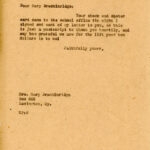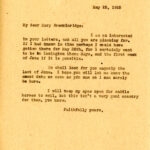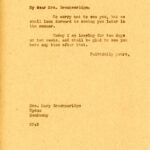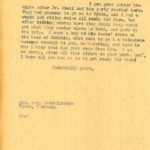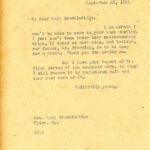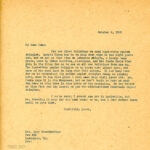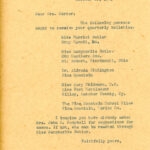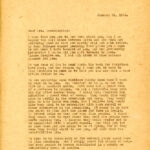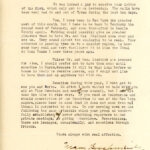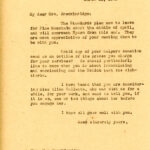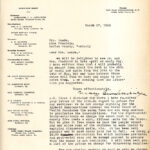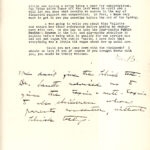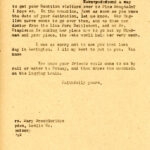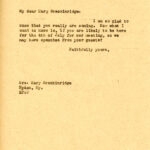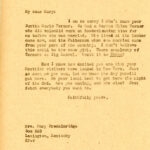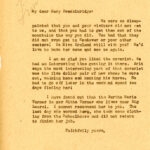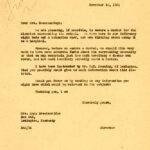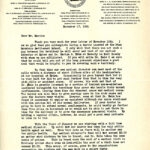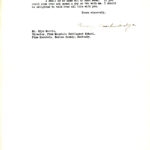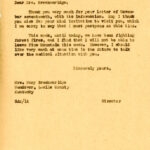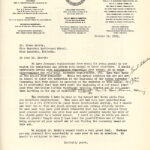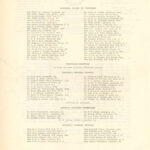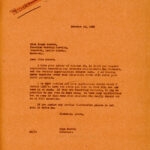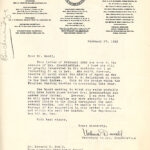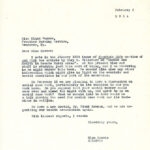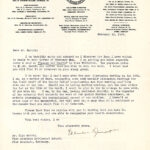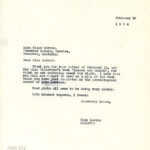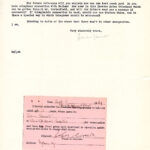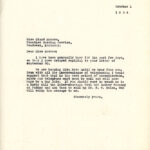Pine Mountain Settlement School
Series 09: BIOGRAPHY
Series 14: MEDICAL
Biography of Mary Breckinridge (1881-1965), FNS Founder
Frontier Nursing and PMSS Correspondence 1925-1938
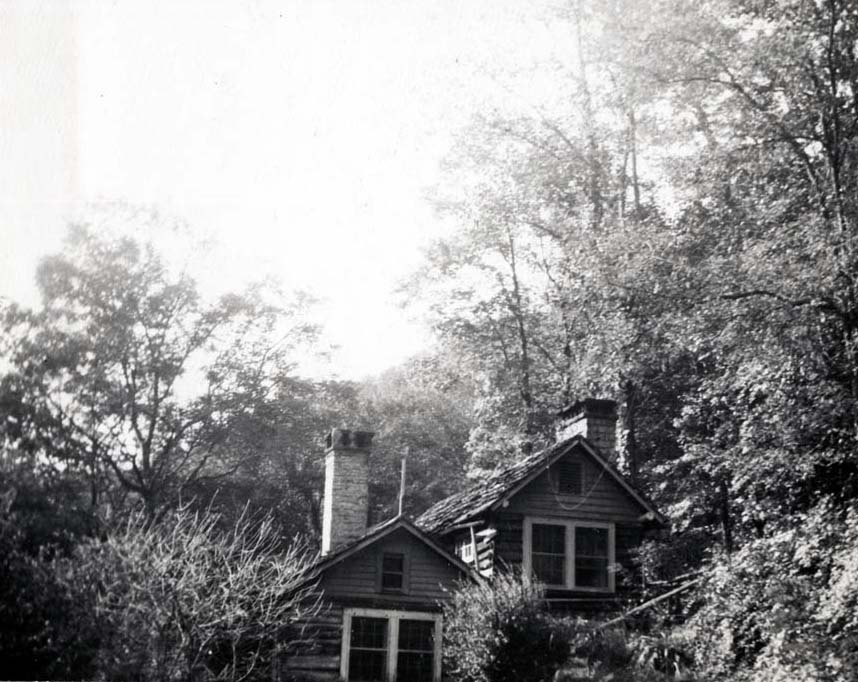
“Frontier Nursing – Wendover.” House in wooded setting,, Wendover, KY. [nace_II_album_064.jpg]
TAGS: Frontier Nursing Service, Wendover Clinic, Mary Breckinridge, Katherine Pettit, roof shingles, Laurel House I, Ethel de Long Zande, Dr. and Mrs. Stoddard, Schick test for diphtheria, vaccinations, Kentucky Committee for Mothers and Babies, Glyn Morris, Miss Bland Morrow, Wilma Duvall, Social Service Directors, Dr. Kenneth Gould, students, Mary B. Willeford
MEDICAL Frontier Nursing and PMSS Correspondence 1925-1938
A principal correspondent in this series of letters, Mary Carson Breckinridge, (February 17, 1881 – May 16, 1965) was well-known in medical care circles and in the prominent families of Kentucky. Like her cousin, the feminist luminary Sophonisba Preston Breckinridge, she has many “firsts” in her history. She was a ground-breaking leader in rural health care and complemented the efforts of Hindman Settlement School, Pine Mountain Settlement School, and other eastern Kentucky social and educational services and healthcare initiatives.
MARY BRECKINRIDGE Biography
Mary Breckinridge was not a native of Kentucky but was deeply rooted in its history and early families. She was born in Memphis, Tennessee, where her father was a prosperous cotton farmer. However, she had roots deep in the state of Kentucky and the Nation. As the granddaughter of Lexington-born John Cabell Breckinridge, Vice President of the United States under James Buchanan, she could also name six members of the United States House of Representatives, two US Senators, a cabinet member, two ambassadors, one US Vice President (her grandfather), and another also-ran candidate for President. She was naturally drawn to the State of Kentucky where the Breckinridge family had a long history and a hefty presence. She also had a direct link to the Pettit family and the Bullock family in Lexington, as they were related through marriage.
Sophonisba Breckinridge, five years younger than Mary, was a well-known activist, prominent figure in the Social Settlement Movemen,t and the first woman to pass the bar in Kentucky. Sophonisba accompanied Katherine Pettit on the first expedition to form a Summer Reading Clinic at Hindman that later led to the founding of Hindman Settlement School by Pettit and May Stone in 1902. She became part of the Chicago Hull House project with Jane Addams in 1907 and earned a Ph.D in Political Science and Economics from the University of Chicago. She was later hired to by the University and created the first professional degree program for social work at the institution.
Many of the Breckinridge women had strong commitments to the Settlement Movement, to the Kentucky Women’s Club, and to social services, generally. However, it was not the Settlement Movement and Women’s Clubs that eventually fully captured Mary Breckinridge’s attention. It was the troubled and growing need for medical care in the Appalachian mountain communities for women and children. Like her cousin Sophonisba, she focused in on social services specifically aimed at women and children. She was interested in nursing as a means to build a social service platform, but instead of a profession, she found a passion.
In 1903 she married attorney Henry Ruffiner and settled into a typical trajectory of wife, mother, but added committed social activist. Her husband died suddenly in 1906 of appendicitis, just three years into their marriage. The early death of her husband and the activist women with whom she associated led her to seek training as a nurse at New York’s St. Luke’s Hospital. She graduated from the St. Luke’s program in 1910 as a nurse and with training in hygiene. The fact that she had been raised in a wealthy and privileged family seemingly made little difference in her drive to chart her own course. Wealth just enabled a tendency already established in the family for risk-taking and for bold moves. Her grandfather John Cabell Breckinridge was a dynamic Democratic political leader in the Kentucky Legislature and then in the U.S. Senate but he faced a political firestorm when he broke with Buchanan and the Democratic Party in Kentucky to join the Confederacy. The reasons were many, as were the conflicts, but out of that troubled time he continues to be remembered as a mediator by both sides of the conflict.
Mary Breckinridge’s father, also a public figure, became a high-profile mediator, serving as ambassador to Russia under the Grover Cleveland administration. As the child of a diplomat, Mary had access to private tutors and later many open doors to education and experience through the diplomatic network. It would appear that she was blessed by privilege and courage but she was, in actuality, troubled by tragedy and a deep sense of responsibility.
Following the death of her first husband and the quick degree in nursing in New York in 1912, she met Richard Ryan Thompson, married him, and moved to Arkansas where her father served as a Representative. There she taught French and Hygiene at the Crescent College and Conservatory for Young Women, in Eureka Springs, Arkansas, where her husband served as President. She quickly had two children with Thompson. The first child, a daughter, died shortly after birth, and the second, a son, died at the age of four following an attack of appendicitis. The year was 1918 and WWI was raging in Europe and many women were leaving for France to provide nursing and canteen service to the troops.
Mary worked briefly in June as a Public Health Nurse in Washington, D.C., but then shifted her focus to Europe. She signed on to the American Committee for Devastated France and, in that organization, she poured herself into work for women and children in France by organizing programs for pregnant women and children, disaster relief, and by developing an Association for Child-Hygiene and Visiting Nurses. For her work during the conflict, she was awarded the Medaille Reconnaisance Francaise.
Even in the tumult in her life, the deep loss of her children was apparently never far from her mind and then compounded by evidence of her husband’s lack of fidelity. She divorced him in 1920 when she returned to the States. She had been sharply wounded on the home front, but her strength was evident in her focus when she returned to the States in 1920. She took back her maiden name, “Mary Breckinridge,” and charged forward. Alone, but focused, she again turned to her nurse’s training and to her deep commitment to women and children. By 1921 she was in Eastern Kentucky putting her ideas to work.
In Eastern Kentucky, she founded the Kentucky Committee for Mothers and Babies and shortly afterward that innovative program became known as the Frontier Nursing Service (FNS). Breckinridge then continued her education with postgraduate courses in Public Health at Columbia Teachers College from 1921-22, as she realized the need for understanding the larger health picture.
The practice of midwifery had not been part of her American training and intrigued by what she had learned in Europe, and finding no comparable programs in the USA, she again left for England in the Fall of 1923. England had a certification program in midwifery at the British Hospital for Women and Babies in Woolwich, England. She enrolled and upon completion of her training she trained further in the Highlands of Scotland and the rugged Outer Hebrides islands, a desolate and impoverished region not unlike that of the pioneer settlers of Eastern Kentucky in the 1920s.
She began training her nurses for the Frontier Nursing Program in England and also bringing English nurses to work at Wendover, Kentucky. But the nurses’ training in Europe was expensive and she used her Public Health knowledge to develop a domestic training program that carried signatures of the British program but was geared to local needs. Breckinridge’s southeastern Kentucky program became the first program in the country to provide midwife training and services to rural populations and is now recognized as a model for rural health care delivery.
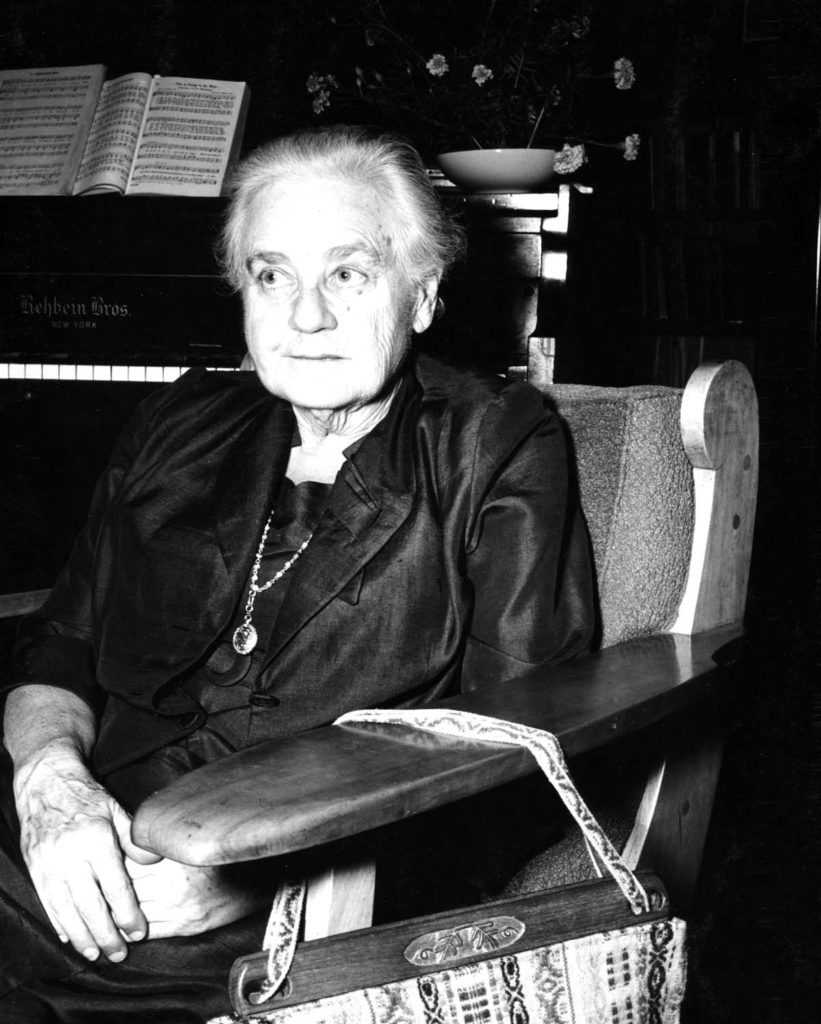
VII 65 Life & Work. 40th Anniversary of PMSS. “Mrs. Mary Breckinridge, at Pine Mountain. 1953” [65_events-visitors_010.jpg]
Mary Breckinridge was smart, motivated, and a persuasive speaker and fund-raiser. Her advocacy for Mothers and Babies and the praise for her entrepreneurial work in founding the Frontier Nursing Service in Eastern Kentucky was well deserved. The FNS has been acknowledged by State health officials as the primary reason for the drop in maternal mortality and infant mortality in Kentucky and it continues to influence the growth of rural health nursing across the country.
MARY BRECKINRIDGE: Interaction with PMSS
By 1939 Breckinridge had expanded her Frontier Nursing Service to include an educational program and looked to local educational programs for models. She was in regular contact with Glyn Morris, the Director at Pine Mountain Settlement School who had implemented an exemplary industrial training component in the School’s progressive educational model. Glyn had also attended Columbia Teacher’s College and was working with Ruth Strang and the Teacher’s College to implement a Rural Youth Guidance program in nearby Harlan County. Breckinridge and Morris had frequent exchanges during his tenure from 1931-1940 and later when he assumed the role of Principal of the Harlan County Evarts school system.
FRONTIER NURSING SERVICE Today
When Breckinridge founded the Frontier School of Midwifery and Family Nursing, it was the first such school in the United States. The FNS continues its educational mission today. It has added a doctoral degree in nursing to its roster and provides online instruction, but has recently moved the School out of the mountains and into the more reliable digital stream of distance learning. Gone are the horses and jeeps as roads improved and as Appalachian Regional Hospitals moved into the Central Appalachians. Payment is now in cash and insurance, not in goods as it once was. Prenatal, family care, childbirth care, and pediatric care has shown a dramatic reduction in mortality of mothers and babies in rural regions and in needy urban areas of the country, due in large part to the early work of the Frontier Nursing Service and their training program.
**********
In 1942 Mary Breckinridge was awarded an Honorary Doctorate from the University of Kentucky for her work with the Frontier Nursing Service. Mary Breckinridge died in 1965. While the FNS operated under her guidance, the Wendover, Kentucky, Mary Breckinridge Hospital is recorded as having served over the course of Breckinridge’s tenure as Director, approximately 50,000 medical cases. Another important statistic to pay attention to is the record showing over 250,000 inoculations in the FNS clinics that significantly reduced common childhood and adult illnesses across the mountain region.
The following selected correspondence provides good insight into the reciprocal ideas and cooperation that fed the development of both medical care and educational advancement in the mountains of Eastern Kentucky in the first three decades of the twentieth century.
CORRESPONDENCE: Mary Breckinridge & PMSS, 1925-1938
[NOTE: The full names of students are considered private material. Therefore, in the list of Contents below, students’ names are not included and the Content is marked with”RESTRICTED IMAGE”. Also, the corresponding images are not publicly displayed in the Gallery. Access may be provided on request, pending approval of Pine Mountain Settlement School and the archivist of the PMSS Collections. Contact the main PMSS Office for information.]
[NOTE: Letters from PMSS staff in the PMSS Collections are carbon copies, typewritten, unsigned, and meant for the Office files. The original signed copies were sent to the correspondents. The initials at the bottom left of most PMSS letters indicate the writer (along with the initials of the secretary). For example,“KP” refers to Katherine Pettit. Letters from Mary Breckinridge, R.N. are typewritten originals on the letterhead for Frontier Nursing Service unless specified otherwise.]
1925 LETTERS
001 April 9, 1925. To Mary Breckinridge, ℅ Mr. Cabell Bullock,* Lexington, KY, from KP (Katherine Pettit), who is very interested in Breckinridge’s letter and suggests that she contact Mrs. John C. Campbell and Miss Marguerite Butler and share her plans with them.
*Cabell Breckinridge Bullock (1840-1932) was family and a Lawyer in Lexington.
002 April 10, 1925. To Breckinridge from KP (Pettit), thanking her for her $10 check and Easter card.
003 May 25, 1925. To Breckinridge from KP (Pettit), expressing support for Breckinridge’s plans and anticipating her visit in June.
004 July 18, 1925. To Breckinridge, Hyden, KY, from KP (Pettit), regretting that Breckinridge will not visit until later in the summer.
005 August 31, 1925. To Breckinridge from KP (Pettit), explaining that Dr. [Irvin ?] Abell and his party decided not to visit Hyden.
006 September 23, 1925. To Breckinridge from KP (Pettit), who cannot attend the next meeting; asks for Breckinridge’s “report of the first survey of the mountain work” to copy.
007 October 2, 1925. To Breckinridge from KP (Pettit), who tells that “hand-riven poplar shingles” were used on the first PMSS buildings. When Laurel House was re-done, asbestos shingles were used, which Mrs. Zande prefers to use from now on. She wonders “why yellow poplar shingles decay so quickly here….” Mentions Mr. (Luigi) Zande and Mr. (William) Browning.
008 October 26, 1925. To Mrs. Joseph Carter, Versailles, KY, from KP (Pettit), who sends names and addresses of persons who “ought to receive your quarterly bulletins,” including Harriet Butler, Marguerite Butler, Dr. Alfreda Withington, Miss Mary Skidmore, R.N, and the PMSS school files. She suggests asking Mrs. John C. Campbell for names.
1926-1928 LETTERS
009 January 21, 1926. To Breckinridge from (unsigned, apparently Ethel de Long Zande), who thanks her for sending a book to Berto (Zande). She expects a visit from Dr. and Mrs. Stoddard, a medical doctor and nurse, and hopes to send them on to Breckinridge. She gives a description of their background and their desire to “settle in the mountains and work”; asks Breckinridge to help find them a place in Leslie County.
010 January 30, 1926. Mary Breckinridge to Ethel de Long Zande discusses the visit by Dr. and Mrs. Stoddard and the reporting of Frontier Nursing work:
“…If you read an inaccurate and stupid description of our Committee in one of the New York papers, please bear in mind that it does not come from me! though it purported to do so. In our nursing work, we are following the same principle which your group so wonderfully established, of never admitting reporters to our private meetings, or giving interviews. Nevertheless, there are leakages, occasionally, and sometimes through friends.”
011 March 11, 1926. Ethel de Long Zande to Mary Breckinridge. Asks what the Hyden clinic does “…about inoculating and vaccinating and the Schick test for Diphtheria.”
012-012a March 17, 1926. Mary Breckinridge on letterhead for Kentucky Committee for Mothers and Babies (of which she is Director), Hyden, KY, to Ethel de Long Zande. Breckinridge advises that no charges are made for vaccinations but they do charge for obstetrics and “…are working on the Scottish Highland system of giving free visits and making a drive twice a year for subscriptions.” Handwritten note: “We don’t give the Schick test* … advised to give the toxin and anti-toxin to the children …””
013 April 18, 1928. Ethel de Long Zande to Mary Breckinridge regarding visitors proposing to come to PMSS.
014 May 22, 1928. To Mary Breckinridge from Katherine Pettit, who hopes she will come to PMSS in time for the July 4th meeting, “so we may have speeches from your guests….”
015 June 14, 1928. Katherine Pettit to Mary Breckinridge regarding the “Scottish” Dr. Stoddard and wife’s visit to PMSS. She invites others to come along, as well.
016 July 9, 1928. Katherine Pettit to Mary Breckinridge, regretting that the Stoddards never made it to PMSS or even to Wendover, KY. Asks about Kate Ireland. Tells about Brit Wilder having lost his horse after delivering a coverlet to Breckinridge.
1931-1932 LETTERS
017 Nov. 10, 1931. New Director at PMSS, Glyn Morris, to Mary Breckinridge. Notes that PMSS is thinking of turning the School Clinic into a hospital. It has eight beds but needs a doctor. Asks how much territory a Doctor can cover.
018-018a Nov. 17, 1931. Mary Breckinridge to Glyn Morris. She notes the medical center at Beverly, KY, (Red Bird) fills some gaps for care in the area. She suggests that a doctor can meet most of the calls within a distance of about fifteen miles. She suggests that five miles is best for infant deliveries as timeliness is important. Says that Hyden’s medical director is also the local public health agent. He charges no more than $3.00 a visit. She invites Morris to visit the Wendover clinic in Hyden.
019 Nov. 25, 1931, Glyn Morris to Mary Breckinridge. He declines invitation to visit as the School is fighting forest fires and he cannot leave the campus.
020-020a October 19, 1932. Miss Bland Morrow, Social Service Director at Wendover Clinic, to Glyn Morris. Requests information on educational services at Pine Mountain Settlement for three girls from their area. She acknowledges visit of Dr. (Kenneth) Gould from PMSS. Reverse side of this letter lists members of the Frontier Nursing Service (FNS) National Board of Trustees, Honorary Trustees, National Medical Council (including the Medical Advisory Committee and National Nursing Council.
021 October 24, 1932. Glyn Morris to Bland Morrow. He provides information regarding entrance to the School at Pine Mountain Settlement for Morrow’s recommended students.
1933 LETTERS
022 February 27, 1933. Wilma Duvall (Secretary of Mary Breckinridge) to Dr. Kenneth Gould, physician at PMSS. Notes that Breckinridge is on a cruise (to the West Indies sponsored by the Frontier Nursing Service) and won’t be able to answer his letter soon. However, she is sure that Frontier Nursing cannot assist Dr. Gould in his requests for services, as “…The depression has hit us too.”
023-023a May 11, 1933. To Glyn Morris from Bland Morrow, FNS Social Service Director, expressing appreciation for her and Miss Willeford’s visit to PMSS. (Mary B. Willeford, R.N., Ph.D., FNS Assistant Director.) She is sending “short social histories for the two girls about who I talked to both you and Miss Frank” which must be kept confidential. She is happy for a certain student’s improvement at school and suggests how she may go forward. [RESTRICTED IMAGES]
024 July 7, 1933. Glyn Morris to Bland Morrow. He will “have more definite information about (a student) for her, so that Morrow can talk with her this summer. [RESTRICTED IMAGE]
025-025a August 16, 1933. Bland Morrow to Glyn Morris. Morrow sends fees for three girls to attend Pine Mountain. [RESTRICTED IMAGES]
026 August 16, 1933. Glyn Morris to Bland Morrow. Morris seeks a placement at Frontier Nursing for a PMSS graduate (1933) who had assisted the infirmary nurse for two years. and wants to eventually become a nurse. [RESTRICTED IMAGE]
027 September 20, 1933. Bland Morrow to Glyn Morris, asking for information about a former PMSS student. [RESTRICTED IMAGE]
028 September 26, 1933. Glyn Morris to Bland Morrow. He sends information she requested for a PMSS student, mentioning that she only stayed at PMSS for six weeks. [RESTRICTED IMAGE]
1934 LETTERS
029 February 2, 1934. Glyn Morris to Bland Morrow. Morris asks to borrow Mary B. Willeford’s book, INCOME AND HEALTH IN REMOTE RURAL AMERICA, from FNS and if the social worker at FNS could come to give a talk at PMSS “…on social casework and its technique in outline.” He announces the hire of Dr. Frank Newman at PMSS and that the School is organizing their health association again.
030 February 13, 1934. Bland Morrow to Glyn Morris. Sends requested book and declines invitation to come to PMSS for discussion group unless it is later in the month. She cites an article she has written on psychological problems in the Alpha Omericon Phi magazine, the sorority that supports the work of the Social Services department at Wendover, KY.
031 February 16, 1934. Glyn Morris to Bland Morrow enclosing a check for the book Income and Health…. which he purchased.
032 April 24, 1934. Glyn Morris to Bland Morrow giving a progress report on two girls recommended to PMSS. [RESTRICTED IMAGE]
033 April 27, 1934. Bland Morrow to Glyn Morris regarding fees for two girls at PMSS which their sister is paying. [RESTRICTED IMAGE]
034 May 4, 1934. Barbara Faulkner, bookkeeper at PMSS, to Bland Morrow regarding receipt of check for three girls. [RESTRICTED IMAGE]
035 June 14, 1934. Bland Morrow to Glyn Morris, expressing concerns regarding progress of the three girls she had sent to PMSS. Encloses an article and asks for Morris’s reaction to “this interpretation of some of our difficulties in mountain work.” [RESTRICTED IMAGE]
036 July 7, 1934. To Bland Morrow from Glyn Morris, who comments on the article she had sent:
“I suppose that until the government attacks the whole thing on a large scale, there is nothing we can do except try to alleviate the depressing conditions which we find in the little areas which are our spheres of interest. We have had some very interesting discussion here at Pine Mountain, about the whole problem, trying to crystallize our ideas about our own work, and while we cannot do much in an economic way, we do feel that our task is more and more to make our young people conscious of their own problems, and of the forces which mould the particular channel of life in which they find themselves. We feel that to meet our challenge we must part with the routine of formalized curriculum and spend more of our time not in teaching but ‘guiding’ our young people through life’s experiences as we find them here.”
Morris gives his thoughts about keeping at PMSS two students that she had recommended for at least another year. [RESTRICTED IMAGE]
037 July 11, 1934. To Glyn Morris from Bland Morrow, continuing their “discussion of the progress and potentialities” of two students. Comments on another student’s improvements who is working for her. [RESTRICTED IMAGE]
038 July 20, 1934. To Glyn Morris from Bland Morrow, reporting that one of her girls has decided to return to PMSS this year. She encloses payments for the three girls. She will get him the information on the prospective PMSS students he had listed. [RESTRICTED IMAGE]
039 July 20, 1934. To Bland Morrow from (unsigned, apparently Morris), who had visited Hyden and left a list for her of prospective PMSS students. He explains that they live too far from Hyden to visit and hopes the FNS social service department can provide information about them. He will place the two Leslie County students at PMSS per their applications that Morrow sent him. He encloses several catalogs and application blanks. [RESTRICTED IMAGE]
040 July 26, 1934. To Glyn Morris from Bland Morrow, providing updates on the students she has sent to PMSS, including payments of fees, and background information. [RESTRICTED IMAGE]
041 July 24, 1934. To Bland Morrow from (unsigned, apparently Morris), thanking her for sending the students’ entrance fees and asking if Willard Day of Bowlington, Perry County, is connected with FNS. [RESTRICTED IMAGE]
042-042b July 30, 1934. Three-page letter to Glyn Morris from Bland Morrow, who comments positively about Miss Worcester, who has been with FNS for a number of years. Tells of a father who cannot pay a students’ entrance fees on time and has too high expectations for his children. She advises Morris to write to the father. She provides background information on several other possible students and/or their families and community. [RESTRICTED IMAGES]
043 August 10, 1934. To Bland Morrow from (unsigned; “dictated by Mr. Morris…”) thanking her for her letter and advice about the children. [RESTRICTED IMAGE]
044 August 13, 1934. To Glyn Morris from Bland Morrow, explaining why a student cannot arrive at PMSS by the day specified by Morris. Morrow will help the student arrive the following day. Another student will be arriving on time. [RESTRICTED IMAGE]
045 August 18, 1934. To Glyn Morris from Bland Morrow, reporting that she cannot persuade the father to pay fees for his two children on time or concentrate on just the son’s education. The father, therefore, will be sending his children to the high school in Hyden instead. [RESTRICTED IMAGE]
046 September 1, 1934. To Glyn Morris from Bland Morrow, sending payments for three girls at $3.00 each plus $1 each as a breakage fee. One girl she is sending will need dental work. [RESTRICTED IMAGE]
047 September 21, 1934. To Bland Morrow from Glyn Morris, asking her to send someone to bring a student to the student’s family. [RESTRICTED IMAGE]
048-048a September 20, 1934. Two-page letter to Glyn Morris from Bland Morrow, explaining an agreement with a father of a student who may need an emergency operation and his inability to pay for it; encloses a permission blank with the father’s signature. She describes the various steps she took to contact Morris about this by telephone; asks Morris how to best reach him in the future. [RESTRICTED IMAGES]
049 October 1, 1934. To Bland Morrow from (unsigned, apparently Morris), advising that telephoning is the best method to reach him “since our telegrams must come by mail and will perhaps be a day late.” In an emergency, “call the Inter-mountain Coal and Lumber Company at Putney and ask them to call up Mr. E.M. Nolan, who will relay the message to us.”
1938
050 April 22, 1938. To Glyn Morris from Bland Morrow, asking to meet with Morris on May Day concerning a student and giving the reasons for the need to so. She will be leaving NFS in early June and hopes to “look ahead for this girl.” The special fund for the girl is running out, so she questions whether the girl can return to school next fall. [RESTRICTED IMAGE]
**********
*The Schick test was used for testing for diphtheria. In the 1920s, there were between 100,000 and 200,000 cases of diphtheria each year with 13,000–15,000 deaths. Because of widespread immunization and better living conditions, diphtheria is now rare in the United States.
MEDICAL Frontier Nursing Beginnings: GALLERY
- 001 frontier_nursing_beginnings_001
- 002 frontier_nursing_beginnings_002
- 003 frontier_nursing_beginnings_003
- 004 frontier_nursing_beginnings_004
- 005 frontier_nursing_beginnings_005
- 006 frontier_nursing_beginnings_006
- 007 frontier_nursing_beginnings_007
- 008 frontier_nursing_beginnings_008
- 009 frontier_nursing_beginnings_009
- 010 frontier_nursing_beginnings_010
- 011 frontier_nursing_beginnings_011
- 012 frontier_nursing_beginnings_012
- 012a frontier_nursing_beginnings_012a
- 013 frontier_nursing_beginnings_013
- 014 frontier_nursing_beginnings_014
- 015 frontier_nursing_beginnings_015
- 016 frontier_nursing_beginnings_016
- 017 frontier_nursing_beginnings_017
- 018 frontier_nursing_beginnings_018
- 018a frontier_nursing_beginnings_018a
- 019 frontier_nursing_beginnings_019
- 020 frontier_nursing_beginnings_020
- 020a frontier_nursing_beginnings_020a
- 021 frontier_nursing_beginnings_021
- 022 frontier_nursing_beginnings_022
- 029 frontier_nursing_beginnings_029
- 030 frontier_nursing_beginnings_030
- 031 frontier_nursing_beginnings_031
- 048a frontier_nursing_beginnings_048a
- 049 frontier_nursing_beginnings_049
SEE ALSO:
MEDICAL Introduction
KATHERINE PETTIT Director
GLYN MORRIS Director
KATHERINE PETTIT Camp Cedar Grove
Return To:
BIOGRAPHY – A-Z
MEDICAL Guide
VISITORS Guide to Consultants Guests and Friends of PMS

